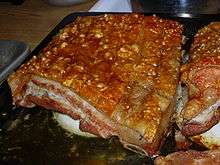Julebord

Julebord is a Scandinavian feast or banquet in the days before Christmas in December and partly November where there is served traditional Christmas food and alcoholic beverages, often in the form of a buffet. The Julebord is organized by employers or organizations and others for the employees or members. Originally, the Julebord belonged to Christmas itself, i.e. the period from Christmas Day and onwards.
Many Julebords are characterized by large amounts of food and drink, both traditional and new, hot and cold dishes. There is often lively partying and the party can be an important social meeting place for colleagues. Julebords are a popular tradition that creates high season for the restaurant industry, the taxi industry and ferry companies Fjord Line, Stena Line, DFDS, Hurtigruten and Color Line during these months. The Norwegian revelers spends billions of Kroner on food and beverages alone during this period.[1]
Etymology
The Norwegian word Julebord which translated means Christmas-table, consists of the words -Jule (adj; Christmas) and bord (table).
History
The tradition of excessive feasting in December has roots that dates back to the ancient Roman Saturnalia customs, which was a pagan Roman feast in December, a week-long wanton and public intoxication where normal rules and prohibitions were set aside.

In Norway, the custom of Julebord originated in the Middle Ages, when it was customary to leave the food all through the Christmas period so poor people and vagrants could feed themselves. Before, it was also common to let the remains of the Christmas meal remain on the table or place it out in the yard on Christmas night in order to appease mythical creatures such as the Trolls or the Nisses which were widely believed to roam the forests. During the night, animals would eat the food, and upon seeing the missing food in the morning, the people would interpret this as the mythical creatures having eaten the food, thus becoming appeased.[2]
Traditional Julebord cuisine
The traditional Norwegian Christmas food is usually served at Julebord events. These include: Rice pudding (risengrysgrøt), Pork belly (Ribbe), pinnekjøtt, medisterpølse, lutefisk, Codfish (Christmas Codfish). It is usually served along with Sauerkraut and raspberry sauce. As it is a rather greasy meal, it is customary to drink Akevitt in order to wash it down.
References
- ↑ Bjerkestrand, Frode. "O' julebord med din skandale". BT.no (in Norwegian). Retrieved 9 December 2012.
- ↑ Tunstad, Erik (16 December 2002). "Den Årlige fylleorgien". forskning.no (in Norwegian). Retrieved 9 December 2012.
